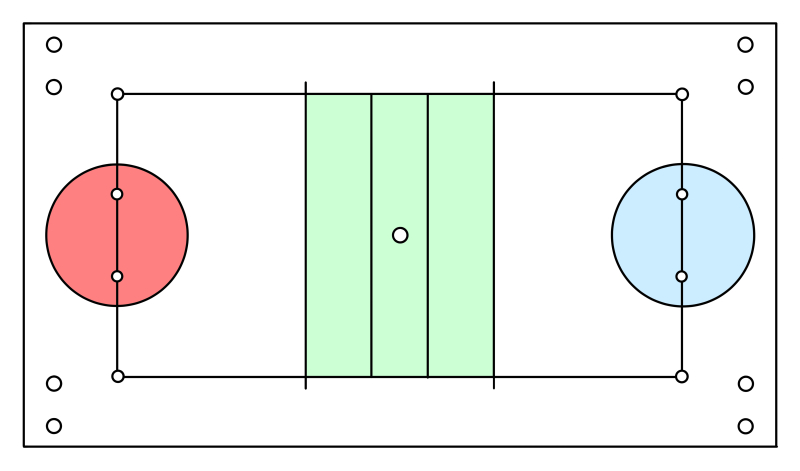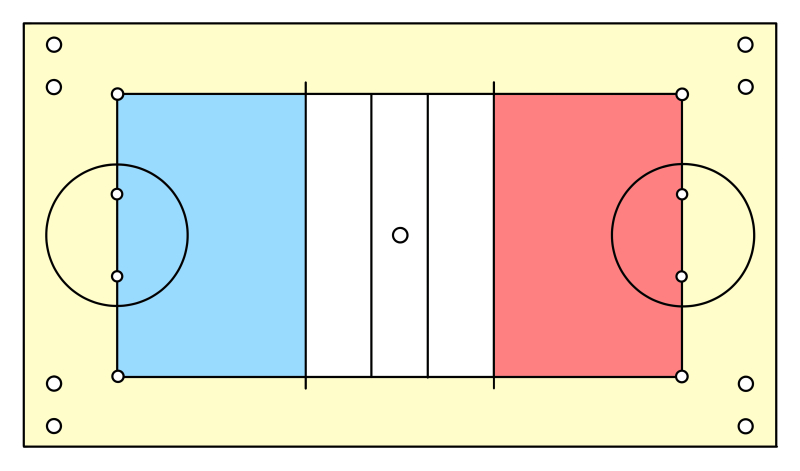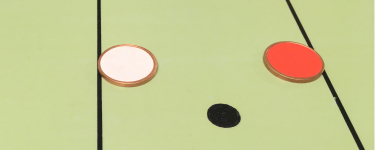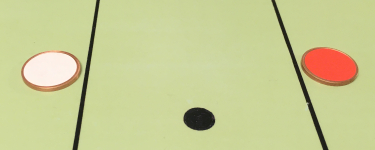Introduction
Pennies
Rule Breaks and Penalties
Spotting and Repositioning
Penalty Flick and the Advantage Rule
Positional and Normal Flicks
Flicking Basics
The Push Shot
Goals
Interceptions
Three-Hit Turn and Foul on Opponent
Three-Zone Hit
The Penny Diameter Rule
Goal Areas and the Two In Rule
The Flick Off
A Goal Flick
Two More Fouls
Quick Reference Guide
The Stack
Tournament and League Play
Remember that you should have mastered both Penny Black and Penny Red before attempting Penny Green.
The game is for two players and is played on a flat, rectangular board upon which the play zones are marked. Spend some time learning the names of the lines and zones shown below before you continue to the next section.
In both diagrams below red defends the left goal and blue the right.
The upper diagram shows the red goal area as red, the blue goal area as blue, and the centre zone as green. The lower diagram shows the red shooting zone as red, the blue shooting zone as blue, and the out zone as yellow.
The correct name for each line is given in the equipment section.


Each player has a team of six counters. These counters are called pennies. Teams have contrasting colours.
One counter is called the green and is usually coloured either light green or white. One counter is the spare and is used only for finding out whether the penny diameter rule has been broken.

"I thought it would take me a long time to learn all the rules. Thankfully, I was wrong."
"If you think about it, you can see how the penny games rules must have evolved. Firstly black, then red, then blue and last of all green."
If you break a rule
then you immediately lose your turn and your opponent carries out the
penalty against you. There are only three penalties: penalty flick
(PF), repositioning (R) and spotting (S). So depending on
the rule you break your opponent will either: take a penalty flick, reposition
one or more of his pennies, or spot one or more of your pennies.
In addition, if from your flick, you break two or more rules, then your
opponent can make the two or more penalties that he is allowed, and in
an order that is to his advantage.
For some rule breaks that you make, your opponent will spot one or more of your pennies. He simply picks up the offending pennies and places them on any free spot behind his own goal line. One penny is allowed on each spot.
For some rule breaks that you make, your opponent will reposition one or more of his own pennies. He simply picks up the offended pennies and repositions them to a place of his advantage. A penny that is repositioned outside a goal area must be nearer to a side line or a zone line than a goal area line, and can be either in the play zone or the out zone. It must not be placed within a penny diameter of the green or any other penny.
A penny cannot be repositioned to where it would be breaking another rule and so cannot be repositioned into a goal area if you already have one there.
A penalty flick is a single flick. The defender places one penny on his goal line between the goal pegs.
Standard Play (The first photo below) The attacker places the green so that it touches the penalty line nearest his opponent's goal. He chooses, picks up and places the penny with which he will take the penalty, so that it touches the other penalty line. See Penny Green Overview/ Animation
Advanced Play (The second photo below) The attacker places the green in his shooting zone, as close as possible to the penalty line without actually touching the line. He chooses, picks up, and places the penny with which he will take the penalty, in his opponent's shooting zone, as close as possible to the other penalty line, but without actually touching the line.


The attacker flicks his chosen penny into the green in an attempt to score a goal.
After the penalty flick the attacker immediately loses his turn and is not allowed a positional flick. That holds true even if the green remains in play.
When you are awarded a penalty flick, you have the option of declining it, and instead, taking immediate possession of the green and going for goal in open play. This is called the advantage rule.
If at the end of your turn you have not broken any rules then, depending on the circumstances, you can flick one, or two, pennies into a position of advantage. These are called positional flicks.
Although a positionally flicked penny is allowed to hit another of your pennies, it is not allowed to touch the green, and must not result in the green or any of your opponent's pennies being moved. If you break this rule then your opponent is awarded a penalty flick.
Any flick which is not a positional flick is called a normal flick.
You can flick only your own pennies - not the green - and must do so cleanly with the nail side of a finger or thumb. No nudging or double hitting is allowed and your hand must not move. If you break this rule your opponent is awarded a penalty flick.
You must flick so that the green does not go into the out zone or or off the board via the side lines or your own goal line. If you break this rule then your opponent is awarded a penalty flick.
You must flick so that no pennies go off the board. If you break this rule then you lose your turn immediately and have no positional flick. Your opponent can spot any of your pennies that you knocked off the board, and can reposition any of his own pennies that you knocked off the board.
"The rule about a foul on your opponent's penny is written to minimise the number of difficult decisions that referees have to make; and, to increase the number of attacking strategies. I couldn't imagine playing the green without this rule."
When you flick one penny at another which is near to it (including the green), then at the instant the penny hits the other your finger (or thumb) may still be in contact with the penny. If that is so then the flick is called a push shot.
If the flicked penny then strikes any other then the push shot is illegal and your opponent is awarded a penalty flick. If the penny you flicked does not strike another then the push shot is legal.
In the diagram below it is impossible for the blue to hit the white (or green!) without being pushed through the red - a push shot. If you do push through the red then if the blue hits the white or any other penny it would be a foul.

The first player to score an agreed number of goals wins the game.
To score a goal you must hit the green from within your shooting zone so that it travels between the goal pegs and completely crosses the goal line.
You cannot score a goal if with the same flick you break a rule.
After scoring a goal you lose your turn immediately and have no positional flick.
If, from your normal, attacking flick, the green collides with one of your opponent's pennies, then as soon as the green stops moving, you lose your turn and have no positional flick. The green is said to have been intercepted. Even if the green bounces off one of your opponent's pennies and back on to one of your own you still lose your turn and have no positional flick.
Because the interception comes into effect only after the green stops moving the attacker is responsible for what happens to the green as it continues to move after the collision. Therefore ...
If the green stops after going into the defender's goal, it is a goal to the attacker. If the green stops after going over the side line, it is a penalty flick to the defender. If the green stops after going over the defender's goal line, but not through the goal pegs, the defender restarts with a goal flick.
In the unlikely event of the green going into the attacker's goal, it is a goal to the defender. In the unlikely event of the green going over the attacker's goal line, but not through the goal pegs, it is a penalty flick to the defender.
If you flick a penny that results in either the green or another of your pennies being moved then it's called a hit. If you make a hit which moves an opponent's penny, don't worry, you have not broken any rule. E.g. You flick your penny straight into a penny of your opponent. Your opponent's penny then hits and moves one of yours. You have made a hit.
If you flick a penny that does not result in either the green or another of your pennies being moved then it's called a miss. If you make a miss but the penny you flicked collides with an opponent's penny it's called a foul, and that's a rule break for which your opponent is awarded a penalty flick.
(You may wish to re-read the above several times so that you understand it well.)
If you make a hit, without an interception then you can try to make another hit.
You are allowed a maximum of three hits per turn.
Whether you make one, two, or three hits, if you have not broken any rules then you are allowed one positional flick to complete your turn.
After your completed turn your opponent begins his turn and so on.
If the green or a penny is touching a zone line then it is in the centre zone. If the green or a penny is touching a goal area line then it is in that goal area. The green is out of play when all of it has crossed over the whole of the perimeter lines and is either in the out zone or off the board.
Except for a penalty flick you must not hit the green so that it travels from one zone, through another zone, and then into another zone. (See Penny Green Overview Animation) This is called a three-zone hit. Even if, on its journey, the green is deflected by another of your pennies, or intercepted by one of your opponent's, it's still a three-zone hit.
If you break this rule your opponent is awarded a penalty flick.
At the end of your attacking turn, which includes your positional flick if you have one, you should not have left any pennies, be they yours or your opponents, nearer to the green than a penny diameter. When defending and making positional flicks the same rule applies.
If you break this rule your opponent can spot your pennies which are within a penny diameter of the green; and, can reposition his own pennies which are within a penny diameter of the green (SR).
